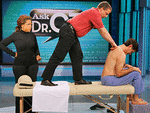
Chronic PainRolfing for Chronic Pain
Rolfing and Chronic Pain
Chronic Pain afflicts large numbers of adults around the world, disrupting their daily activities. Chronic back pain and chronic pain syndrome are a few of the names we know it under. Chronic Pain arises from the muscle and tissue rather than bones and organs, and hence Rolfing, with its emphasis on the fascial system and structural integration of the body, provides a viable and holistic method of chronic pain treatment and chronic pain management.
How Rolfing Addresses Chronic Pain
The human body holds itself erect with pairs of muscle groups functioning within a network of fascial sheaths. These pairs normally function in a complementary relationship with one another. When one pair contracts, the other must extend to maintain the proper balance. An imbalance on any one side could cause chronic pain.
If this relationship is further impaired through injury or chronic tension in one of the groups, the fascia will conform itself to the shortening and the rest of the body will compensate to maintain balance, negatively affecting your posture and structural integration.
The job of Rolfing is to free the shortened fascia, allow the muscles to return to a balanced relationship and to reorganize the body to return to its optimal balance, weaning the body off the fascial compensations. When the myofascial system is organized, gravity causes it to uplift and align the body’s segments and thus releasing the chronic pain.
How Does Rolfing For Chronic Pain Work?
The Rolfer® slowly uses his hands to release adhesions, strains and sprains in the fascia, which is the fibrous web of connective tissue which binds muscles, bones and organs together. The relative flexibility of connective tissues determines how easily muscles will move, therefore the Rolfer® will work on the connective tissue to help free the muscles, and thus releasing the chronic pain.
To align the body segments, Rolfing systematically organizes the body’s soft, connective tissue network. This connective tissue network, know as the myofascial system, provides the structure for the body. It supports the skeleton and soft tissues, positions the bones, determines the direction of muscle pulls and of movement, and gives the body its shape and maintains structural integration.
|

Certified Rolfer®
Vincent Lee
Rolfing was featured in


“Two Hands” 2007 Academy Award. Nominated for documentary film.

Andrew Weil, M.D.
“Good Morning From Dr. Weil.com” An on-line daily newsletter published a health news brief June 25, 2004--“Tip: Is Your Posture Bad? Today’s Tip-Rolfing."